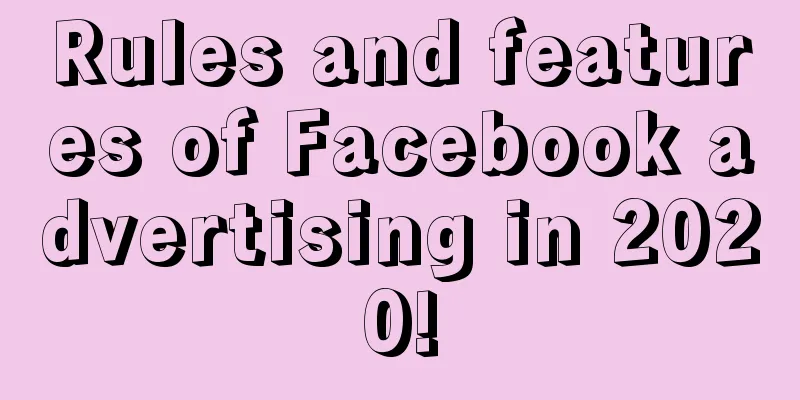One article solves the marketing problems of startups!

Most startup teams tend to be overconfident and self-indulgent, thinking that as long as they create a website and products, and imitate and borrow various promotion channels to burn money, the remaining profit issues will come naturally. As a result, the fire kept burning and eventually the business was burned down. In today's Internet information age, the overwhelming marketing advertisements have long exhausted the little trust in users' hearts. Instead, users have begun to develop a budding sense of doubt and become more and more rational. In addition, the cost for them to obtain detailed information is getting lower and lower, and they can often get a general understanding of the situation just by moving their fingers. In this situation, if you still plan to make a profit by spending money on promotion as you did in the past, the final outcome is predictable. In today's market, successful cases of spending money on promotion are all supported by preliminary foundations! So what to do? The following will be explained in four steps: 1. Tell stories for the company and enhance the brandWhat can spread quickly and deeply rooted in people’s hearts? The answer is stories. For a company, if it wants to gain user recognition and ultimately reach a deal, the first priority is to establish a good image in the minds of users, and corporate stories can do just that. We often hear the saying "Buddha relies on gold ornaments, people rely on clothes", which fully illustrates the importance of packaging, and the corporate story is the outer garment of the company. When creating a corporate story, we can focus on the company's background, corporate culture, corporate growth experience, company founders, core team or core technology, which are often overlooked by many start-ups. For example, the "Churu Orange" that has been widely hyped by the media in recent years is a typical example of a brand based on the story of its founder. Today, it has become the No. 1 inspirational orange brand on the Chinese Internet. The successful creation of its inspirational brand image is inseparable from the indomitable personal charm of its founder, Chu Shijian, who made a comeback in his seventies. 2. Optimize the details of the website and products to improve user experienceAfter most companies have a website and related company introductions, they rush directly into promotion and marketing, hoping to immediately attract a large number of users and generate profits. Little do people know that the most taboo thing in promotion is to carry out large-scale promotion when all aspects are not yet perfect in the early stage. Even if spending money can bring in a large amount of user traffic, the low conversion rate caused by poor experience will make it difficult for users to retain in the end. So how to optimize it? As for operations , our main target objects are websites and products. Knowing the goals, the next thing to do will be much easier. It is nothing more than optimizing the details around the website and products. Website detail optimizationThe core issue of website optimization is to increase user visits and improve user website experience. The starting points are mainly divided into internal system analysis and external reference analysis. Internal system analysis mainly uses website operation data as the basis for analysis (three commonly used indicators: bounce rate, PV and UV, website residence time), so as to modify the website structure, page design and content, conduct in-depth analysis of visitor group attributes, and improve visitor traffic quality; external analysis is mainly through comparison with peer websites to find areas worth learning from. Product detail optimizationTake P2P financial management as an example. If users want to eventually invest, they must go through the three steps of "registration, recharge, and withdrawal". Have we optimized them to the extreme? For example, in terms of registration, what are our registration entry channels? Is the layout of its own entry channels and promotion entry channels reasonable? Have you considered binding the registration method (QQ, WeChat, Weibo)? In order to improve user conversion rate, is there user guidance included in the registration process, is there a task reward mechanism, and is there a trial gold mechanism that can be used to restore the user scenario experience and thus enhance user stickiness. In addition, we should continue to optimize our registration guidance process through user data feedback during the registration process, and ultimately make the product "easier to understand and easier to use" during user use. 3. Expose brands, websites, products, etc. to enhance penetrationWhen the internal foundation is ready, you can start working on related promotional matters, but before that you need to lay the groundwork first. What is a buried point?Before analyzing this, let’s take a look at a set of (the simplest) user consumption behavior process diagrams I compiled. The above figure is a flow chart of user consumption behavior Combined with the above figure, we can assume that potential user A finds the company's advertisement on a certain promotion channel and is interested in the company's products and has the intention to buy. However, because money is involved, user A is cautious. At this time, A searches for relevant information on search engines such as Baidu or 360 for verification based on his previous habits. What we need to do at this time is to ambush various introductions or soft articles that are beneficial to the company in advance and put them in the most conspicuous and easily discovered places, so as to obtain user A's clicks and then influence the user to gain trust. Speaking of this, the so-called embedding points are actually the layout of key traffic nodes. Common and important free traffic nodes include Baidu Encyclopedia, Baidu Knows, and 360 Q&A; paid traffic nodes are mainly based on news source soft article promotion, among which large platforms such as Tencent, Sina, Sohu, and Toutiao are the best. In addition, Baidu launched a new promotion business "knowledge marketing" in 2016. Currently, few people are using it, the promotion cost is relatively low, and the cost performance is high. You can layout the entire page in the Baidu Knows project page, from asking questions to answering and displaying surrounding pictures and links. Baidu Knowledge Marketing page, which has about 7 display positions 4. Choose the appropriate promotion channel according to the positioning of target usersThere are innumerable promotion channels on the market, including search promotion, knowledge marketing, alliances , DSP platforms, media advertising, and outdoor advertising (I will not introduce them in detail here. Next time, I will summarize the commonly used promotion channels in China, and analyze their respective advantages and precautions when using them)... As a promoter, everyone knows one thing, that is - find the most cost-effective channel to promote, and try to gain more users while reducing costs. Then many people only know that the ultimate goal is to achieve high cost performance, but they don’t know how to operate specifically in the process. They often blindly try this channel and that channel to make comparisons. The result of this may be a huge waste of funds. So how do we choose channels? The first thing to consider when choosing a channel is whether it can bring effective traffic. Simply put, you must first locate your user group, and then choose the channel based on the target user group. Here we will encounter another problem: how can we match target users with channels? This requires us to create user profiles for target users, including their gender, age, income, region, education, interests and hobbies, etc. The collection of data in this area can start from within the company. Through online survey software in the form of question and answer options, surveys can be conducted among the company's marketing department and product department, as they are the departments that have the most contact with users. The second way is to obtain it directly from customers over the phone, or by consulting authoritative big data reports such as iResearch, Baidu, Tencent, etc. Conduct commonality analysis on the obtained user portrait data, find out the mainstream culture of the target users, determine their habitat channels, and finally simulate user scenarios to conduct in-depth product exposure and attract users. Mobile application product promotion services: ASO optimization services Qinggua Media information flow This article @邓瑞强 is compiled and published by (APP Top Promotion). Please indicate the author information and source when reprinting! |
<<: 7 steps to help you write a clear plan
>>: 4 analysis models for high-conversion products!
Recommend
Qian Sanqiang: Founder of China's Atomic Energy Science | Childhood of the Hero of "Two Bombs and One Satellite"
Qian Sanqiang, a nuclear physicist, is the founde...
Peng Gang of LeTV: Users are the only ones who decide the direction of product development
On August 27, at the first China Smart TV Industr...
The three stages of brand growth: tools, media, and IP
Marketing does not mean promotion . It is not the...
Redefining the new standard of smart hardcore off-road, Fangcheng Baobao 8 has completely changed the off-road vehicle industry
The off-road vehicle community may really be abou...
How to create a high-click title and double the number of readers in 10 minutes?
In today's world of information explosion and...
8 excellent Android PDF reading apps for viewing documents
[51CTO.com Quick Translation] Most documents or f...
Recommendation! These 9 types of people should drink less coffee. Check if this is you.
Drinking a cup of coffee has become a waking ritu...
How to create an advertisement that touches people’s hearts? Look here
We all know that marketing is a series of activit...
How to make money through online promotion?
1. We-media It refers to the general term for new...
Yahoo and Google have both withdrawn from China, so how can Amazon be the survivor?
Foreign Internet giants that enter the Chinese ma...
Practical sharing: What is the hooked addiction model? How to use it to improve user activity and stickiness?
Let me share a new term, the HOOKED addiction mod...
Why do ducklings swim in a straight line?
As the old saying goes: a person's name refle...
Risk warnings could not stop Zotye from hitting the daily limit 70 times, but it still failed to find a buyer.
Zotye, the "Porsche" that once relied o...
How to increase Kuaishou fans? Kuaishou likes-boosting platform online!
Professional Douyin and Kuaishou likes-boosting p...









